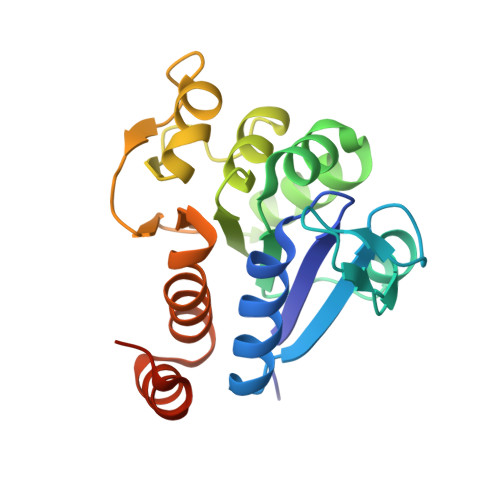Structural Impact of Three Parkinsonism-Associated Missense Mutations on Human DJ-1.
Lakshminarasimhan, M., Maldonado, M.T., Zhou, W., Fink, A.L., Wilson, M.A.(2008) Biochemistry 47: 1381-1392
- PubMed: 18181649
- DOI: https://doi.org/10.1021/bi701189c
- Primary Citation of Related Structures:
2RK3, 2RK4, 2RK6, 3B36, 3B38, 3B3A - PubMed Abstract:
A number of missense mutations in the oxidative stress response protein DJ-1 are implicated in rare forms of familial Parkinsonism. The best-characterized Parkinsonian DJ-1 missense mutation, L166P, disrupts homodimerization and results in a poorly folded protein. The molecular basis by which the other Parkinsonism-associated mutations disrupt the function of DJ-1, however, is incompletely understood. In this study we show that three different Parkinsonism-associated DJ-1 missense mutations (A104T, E163K, and M26I) reduce the thermal stability of DJ-1 in solution by subtly perturbing the structure of DJ-1 without causing major folding defects or loss of dimerization. Atomic resolution X-ray crystallography shows that the A104T substitution introduces water and a discretely disordered residue into the core of the protein, E163K disrupts a key salt bridge with R145, and M26I causes packing defects in the core of the dimer. The deleterious effect of each Parkinsonism-associated mutation on DJ-1 is dissected by analysis of engineered substitutions (M26L, A104V, and E163K/R145E) that partially alleviate each of the defects introduced by the A104T, E163K and M26I mutations. In total, our results suggest that the protective function of DJ-1 can be compromised by diverse perturbations in its structural integrity, particularly near the junctions of secondary structural elements.
Organizational Affiliation:
Department of Biochemistry and the Redox Biology Center, The University of Nebraska-Lincoln, Lincoln, Nebraska 68588-0664, USA.














